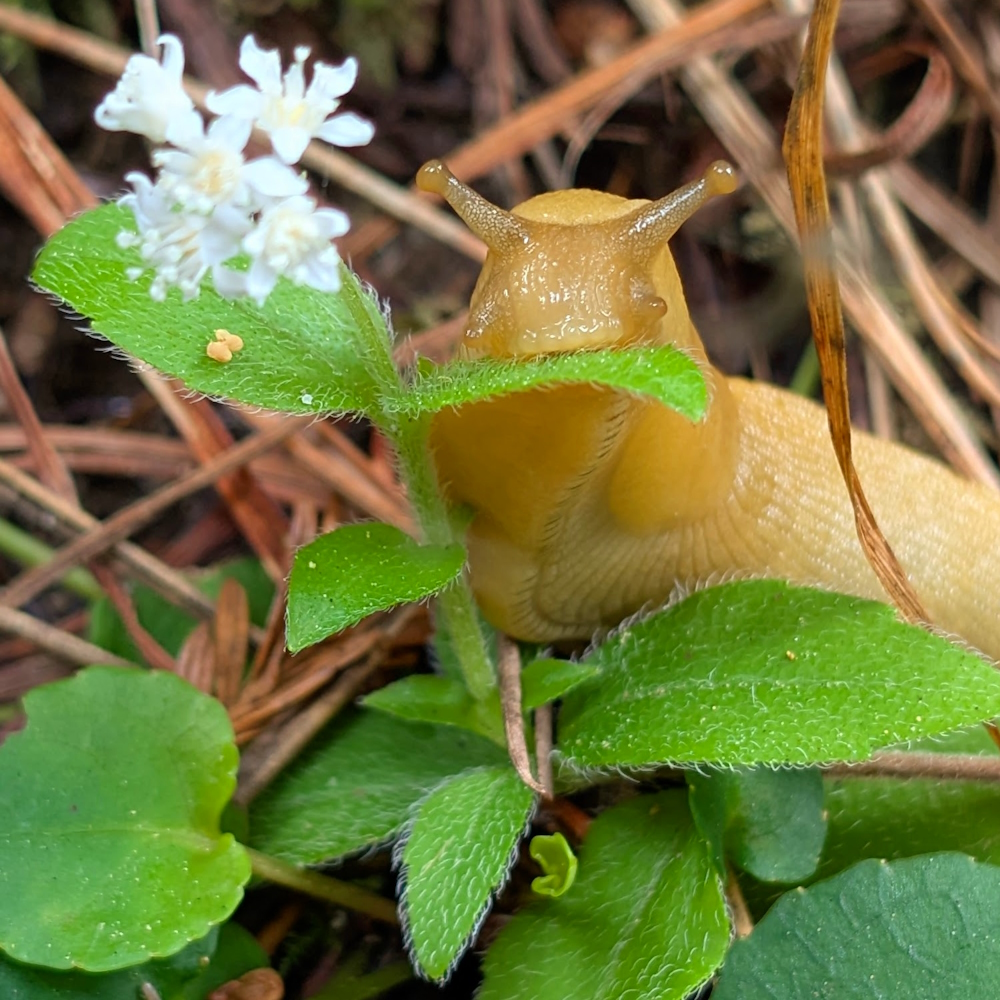
Despite their popularity, Banana Slugs (Ariolimax) aren't nearly as understood as many other gastropods, likely as their low temperature requirements and narrow distribution limit captive study.
I've observed coastal populations of Button's Banana Slugs (A. buttoni) almost daily since 2022, and in early '24 began caring for my first in captivity. While the following guide will focus on this experience and their nuances, it should at least loosely apply to any of the genus.

Notes
Based on Personal Observation
Climate Tolerance
- Their preferred temperature is ~55°F (13°C), as determined through their home distribution on a thermal gradient. Found later to be corroborated by the feeding observations on page 105 of The Foraging Ecology of the Banana Slug — a great dissertation on A. columbianus.
- Signs of stress appear below 65% RH, as slime production sharply increases and activity diminishes.
Behavior
- Generally very timid, to the point that they're often chased off by smaller species (e.g. D. reticulatum). Their most aggressive act is typically in their nibbling during courtship, which may leave scars, however other studies have also documented rare instances of apophallation.
- About half of their daily rest is typically spent at ground-level, with the remainder at heights of up to 10' (3m). This tendency to alternate resting elevation continues in captivity, despite a static climate.
- Rests on the ground are almost always a home, such that they'll return on a daily basis until it becomes too soiled or the climate degrades.
Reproduction in Captivity (See Conditions)
- Sexual maturity is reached at ~5 months of age.
- Mature individuals tend to court any conspecifics they bump into, including hatchings.
- Courtship begins with nibbling, and if reciprocated focuses on their partner's right flank, leading them into an intertwined rotating spiral that only pauses once their gonopores align — a process that takes ~1hr. Only ~20% of encounters see mutual interest, as targets often prove evasive and lose their pursuer in a chase.
- Copulation begins once their courtship spiral stops rotating, and involves 12–22 hours of simultaneous penetration.
- Over the course of 3 months a single pair mated 19 times (every 4–7 days), followed by ~1 day of disinterest in each other. These engagements were observed at all points within the climate gradient, and with no clear duration trend. Tracking stopped arbitrarily rather than due to a change in this behavior.
- Eggs may be laid at as young as 8 months old, and take ~6 weeks to hatch.
- My largest brood was 65 and a result of self-fertilization, with only one individual falling significantly behind the other's growth.
Morphology
- Hatchlings exhibit faint tail spots until either fading away or becoming more defined at ~3 weeks of age.
- Even when self-fertilized, the final presence and composition of spots vary wildly within a given brood.
- The best indication of whether a juvenile will maintain tail spots is the presence of a mantle spot. Such spots are typically associated with spotted tails in adults, and fully-develop within the egg at ~1 month. When the fetus is appropriately oriented the mantle spot is obvious through the eggshell.
- It's exceptionally rare for a spotted individual to have more or fewer than one mantle spot, which when present is directly above their internal shell, which is in turn visible through the mantle until ~2.5 months of age.

Successful Care

Meet Lil' Shrimp — my first Banana Slug. I adopted him at about an inch long, and over the course of 14 months watched him grow into a giant 12" (305mm) slug. It's thanks to him and his babies that I'd first learned much of the following.
Diet
Vegetables (primary diet)
- Dandelion (including flowers), Smooth Hawksbeard, and Smooth Sow Thistle, alternated upon boredom.
- Reconstituted Dried Carrots
Protein & Calcium (once weekly)
- Reconstituted Freeze-Dried Minnows
Grain (once weekly)
- Soggy Rolled Oats
Climate
Temperature
- Soil's surface features a constant range of 55–65°F (13–18°C) by means of a height gradient and custom Substrate Cooler, while the enclosure's lid is ambient (~72°F or ~22°C in my case).
Hydration
- Soil is kept moist, typically resulting in a vertical RH gradient of ~75% to ambient (~55% in my case).
- Slugs directly misted with spring water at least once per day. Consider ~60°F (15°C) water to minimize thermal shock.
Enclosure
Size
- 32-Gal (120L)
- 24"W * 18"D * 18"H (60 * 45 * 45cm)
- Suitable for up to two adults, as they engage in courtship upon most encounters with their conspecifics. Courtship can be stressful, and with two adults it occurred almost daily in this enclosure.
Substrate
- 1–7" (25–175mm) of Gastropoid's Topsoil, with a 60% bias towards 1" (25mm).